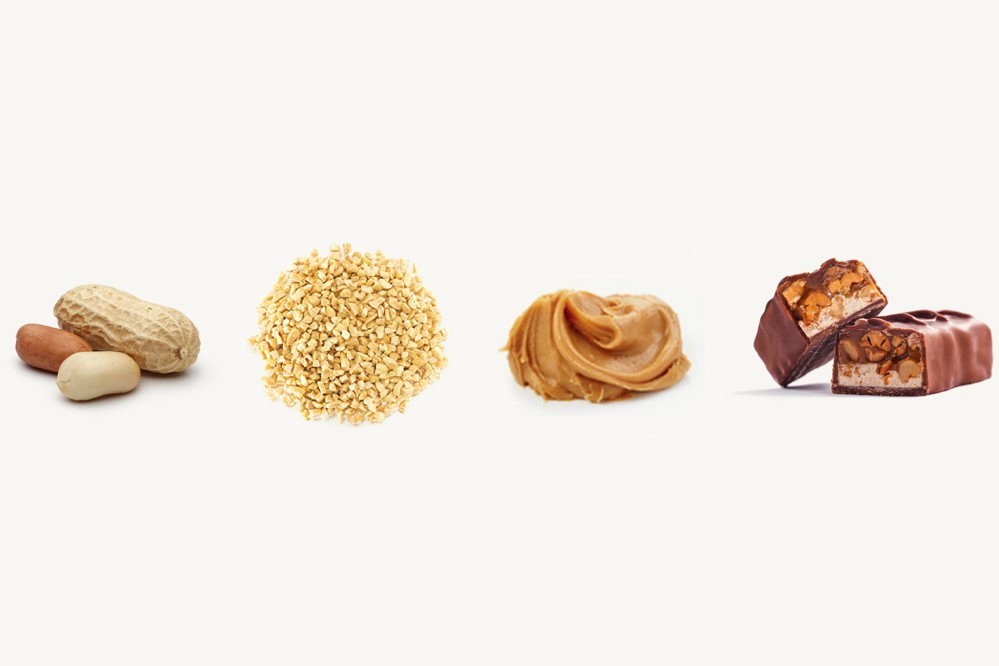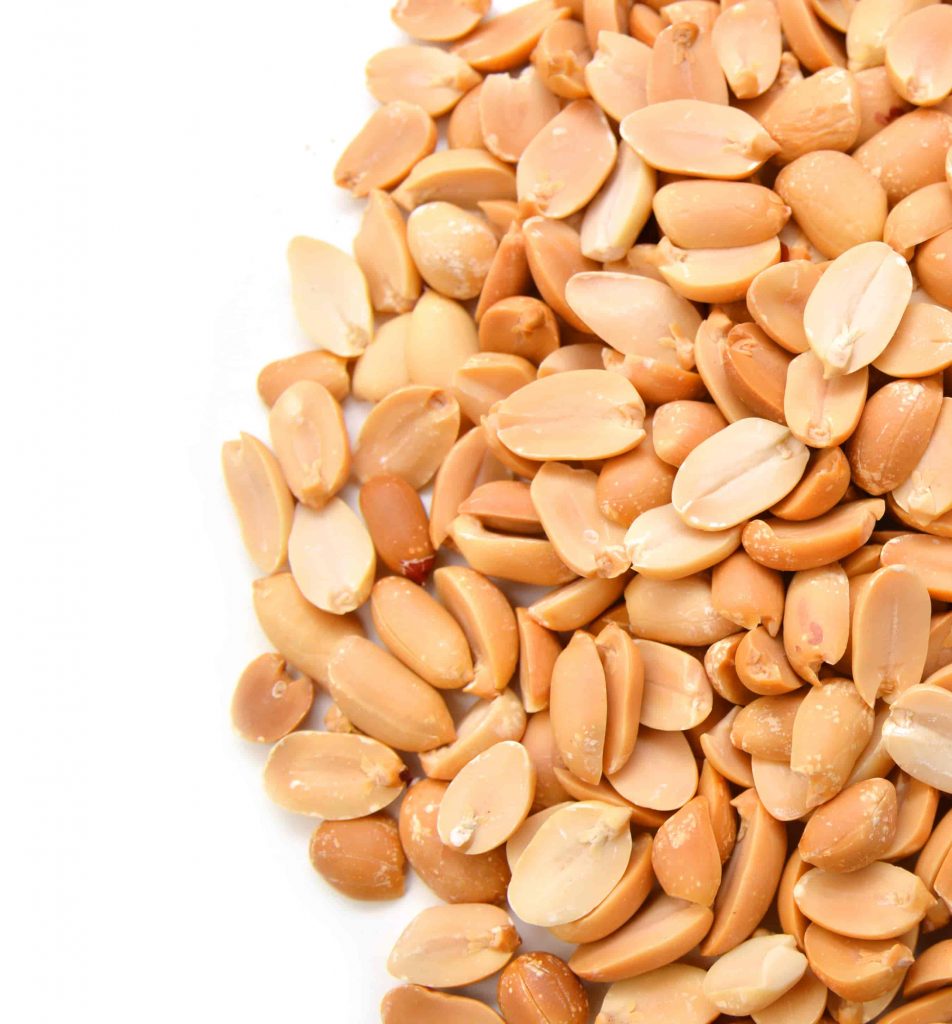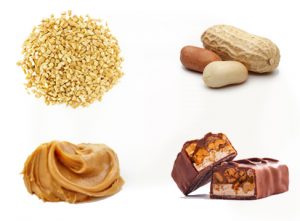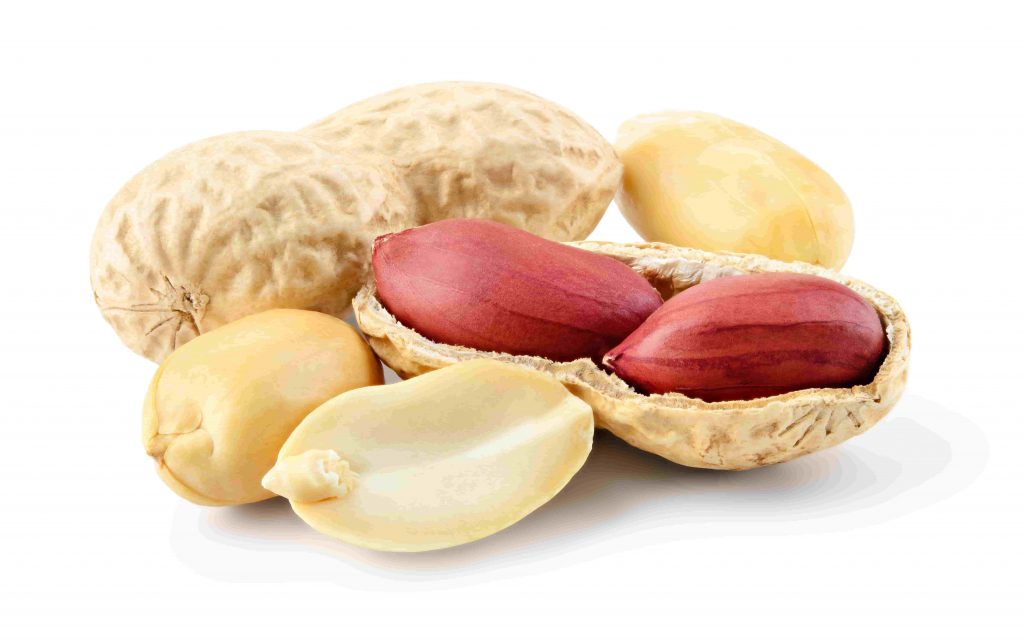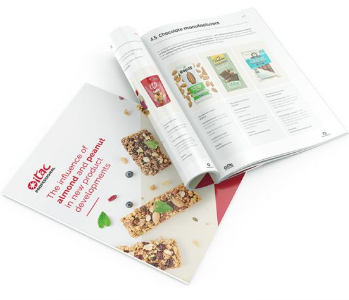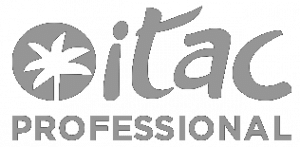Both if you work in the purchasing or procurement department of an industrial food company and if you work in the quality department, the content of this article will be of great interest to you. In this text you will find everything you need to know about the different peanut types and the main aspects you need to keep in mind during its purchasing process.
Main qualities of this ingredient for the industry
Peanut stands out due to its nutritional value. Specifically, peanut kernels contain approximately 50% of fatty acids – mainly monounsaturated and polyunsaturated such as oleic and linoleic acid – and proteins (25%). On the other hand, they also stand out due to their high fibre content, vitamin B6, vitamin E (α-tocopherol); as well as minerals: magnesium, potassium, phosphorous, copper and manganese. Lastly, they are a source of group B proteins and vitamins, such as pantothenic acid1.
Thanks to their high content of vegetable protein and fat (especially monounsaturated), peanuts are a versatile ingredient that can take different forms. It is the main ingredient of peanut butter and it can be transformed into oils, extracts, they can be chopped, halved, diced and turned into peanut flour or pastes1.
Keep learning: Peanut and peanut butter trends
In addition, the nutritional and sensory properties of peanuts make them a unique, differentiating ingredient in a myriad of food products. For this reason, at Itac Professional, the B2B brand of Importaco Group for the food industry, we offer them in a wide range of forms that boost flavours and create a unique texture in products of industries such as chocolate, confectionery and dressings, among others.
Peanut types and growing regions: all you need to know
There are different varieties and types of peanuts, each with different characteristics, uses and growing regions.
1. Runner / Bold peanuts
-
- Its kernels are appealing and have a uniform, medium size. In addition, they are covered by light-red skins that quickly darken. Their flavour is sweeter and this is the most consumed peanut variety. Furthermore, they offer great roasting characteristics and a high performance.
- Main applications in the industry: The intermediate size of Runner peanuts makes them the first choice of producers for use in peanut butters. It is also common for it to be applied in confectionery products with dressings.
- ThisRunner Variety sold by Itac Professional comes for the USA, has a sweeter taste than the Chinese version and is less buttery that the Argentine version. It is an ideal product for pastes. It is also called ‘Bold’.
Runner High – Oleic Peanuts
The development of high oleic peanut has been an important innovation in the peanut industry. The fat content of this peanut includes 75% of oleic acid and 5% of linoleic acid, which implies an oleic/linoleic essential fatty acid ratio that is significantly higher than that of conventional peanut, exceeding 15:12. At Itac Professional we sell High Oleic Runner peanut from Argentina. It is suitable for use in food and the snack industry.
2. Virginia peanuts
-
- The largest variety among all peanut types. Its size makes it a good alternative for processing and to be turned into salted, candied and unpeeled roasted peanuts.
- Thick shell, elongated kernel
- Main applications in the industry: Confectionary, bakery and snack products.
- The Virginia variety sold by Itac Professional stands out due to its large size, crunchiness and low surface damage. It is grown in the USA, Argentina and China, among other places in the world.
DO YOU WORK AT THE FOOD INDUSTRY? ARE YOU LOOKING FOR PEANUTS OR PEANUT BUTTERS?
3. Valencia Peanuts
-
- Valencia peanuts are a type of sweet peanut that is covered by a bright red skin.
- Main applications in the industry: they are commonly used to make all-natural peanut butter. They are also employed in sweet or salty coatings thanks to the characteristics of their skin (high adherence to the kernel).
- At Itac Professional we also carry the Valencia variety. The USA also produces this variety.
4. Spanish / Java Peanuts
-
- Smaller size with brown-reddish skin. This variety has the highest oil content, which makes them highly suitable for oil extraction.
- Main applications in the industry: candies, snacks and peanut butter.
- It is grown in the USA and China, among others. Also called Java.
Do you want to know more about the different types of processed peanuts? Visit this article in our blog.
Basic guide to purchasing peanuts in Europe
After reviewing the different peanut types, now it is time to delve into the purchasing process. As with all foods sold in the European Union, peanuts must comply with a series of highly stringent regulations and requirements that guarantee their safety. There are, for example, a series of limits for pesticide residues, mycotoxins and contaminants that are considered to be harmful. This legislation also includes imported products.
These are the most important factors that must be considered when importing and buying peanuts for consumption within the European Union:
1. Peanut quality factors
In order to guarantee the maximum possible safety for the peanuts, producers and processors apply all kinds of good practices strategies all the way from the field, through manufacturing to the storage of these products. Below we highlight a few details regarding these practices.
-
- Good agricultural practices: their goal is to train growers in regard to the guidelines and principles that they must apply to the production and post-production processes in their exploitation, with the purpose of offering a safe and healthy peanut, minimising risks such as pathogens, contaminants and pesticides linked to pest control.
- Good manufacturing practices: they define the processes that must be applied during the processing, packaging, storage and transportation stages by handlers in order to ensure an optimal product quality.
- Good storage practices: which establish the procedures that must be applied by handlers during the post-harvest, processing and transportation stages in order to control aspects such as humidity content and temperature, and thereby minimise mould (especially aflatoxins) and insect levels.
- Hazard Analysis Critical Control Point (HACCP), which offers a food safety preventive system that aims to identify, evaluate and control the risk of biological, chemical and physical hazards in the production processes.
Peanuts are manufactured by taking into account the following quality criteria.
At a general level:
It must be certified that they are safe and suitable for processing for human consumption.
They must be free from undesired flavours and odours, as well as insects and live mites.
At a specific level, it is important to take into account the following quality criteria, among others:
-
- The peanut moisture content.
- Impurities: with a focus on animal impurities (including dead insects).
- The presence of mouldy, rancid or decomposed kernels.
- The possibility of containing other foreign matter, whether organic or inorganic.
2. Microbiological contaminants
When talking about peanuts and peanut types, we must keep in mind the possible chemical or microbiological contaminants that they might contain, including: total plate count, the presence of yeast and mould, Enterobacteriaceae, Coliforms, E. coli and the negative Salmonella value.
It is essential to make sure that the peanut manufacturers are making the necessary controls to detect salmonella and E. Coli, two of the most frequently found bacteria in processed foods that often cause public health problems.
At Itac Professional we perform microbiological tests that include:
-
- Moulds and yeasts.
- Enterobacteriaceae.
- E. coli.
- Salmonella spp.
Recommended reading: Peanut traceability process at Itac Professional
3. Levels of Mycotoxins and aflatoxins
The presence of mycotoxins and, in particular, aflatoxins – chemical substances produced by toxicogenic strains of mould such as Aspergillus flavus and Aspergillus – is one of the main reasons why a specific peanut batch might be declared to be unfit for consumption in the European Union.
The maximum allowed levels of aflatoxins in peanuts varies depending on each region of origin, and these levels often change in the legislation, which is why it is significantly important for your supplier to be familiar with these regulations and offer you as much support as possible in this regard.
Keep learning: Specialising in almonds and peanuts, from the source all the way to the customer
4. Food Safety Certificates
Most European buyers require a certification recognised by the Global Food Safety Initiative (GFSI). For peanuts, the most popular certificates are:
-
- International Featured Standard (IFS).
- British Retail Consortium Global Standards (BRCGS).
5. Pesticides
The European Union establishes maximum residue limits (MRL) for pesticides present in food products. Products that have a higher concentration of pesticide residue than allowed are withdrawn from the European market. It is uncommon to find high levels of pesticides in peanuts, since the shell – where residues can accumulate – is removed before consumption.
The European Union periodically publishes a list of pesticides that are authorised for use in the European Union. This list is updated regularly. At Importaco Group we train and audit our farmers and producers to guarantee that these products are correctly applied and ensure the lowest environmental impact.
6. Analysis of sensory attributes and physical parameters
Sensory attributes are broken down into:
– Visual characteristics: Related to the aspect of the product. Colour, size, colour & size uniformity, etc.
– Organoleptic characteristics: Related to the odour and flavour of the product. Saltiness, presence of atypical flavours or odours, etc.
– Textural characteristics: Related to the texture of the product. Firmness, crunchiness, etc.
At Itac Professional we perform the appropriate sensory analyses to guarantee that our peanuts have the best quality before they are sold to industrial producers.
Regarding the physical parameters, it is important to take into account the following aspects:
1 Typical pod defects that must be examined
-
- Empty pods: pods that contain no kernels.
- Damaged pods:
-
-
- Shrivelled pods (stunted, shrunken pods).
- Pods that have cracks or broken sections that cause visible holes or weaken a large section of the pod.
-
-
- Discoloured pods: pods that have a dark discoloration caused by mould, spots or other features that affect 50% or more of the pod’s surface.
2 Typical kernel defects that must be examined
-
- Damaged kernels:
-
-
- Freeze damaged kernels, which results in a hard, translucent or discoloured pulp.
- Shrivelled, stunted and shrunken kernels.
- Insect damage or holes caused by worms.
- Mechanical damages
- Sprouted kernels.
-
-
- Discoloured kernels: the kernels are not damaged by have been affected by one or more of the following factors:
-
-
- Pulp (cotyledon) discolouration that is darker than a light yellow colour or involves more than a slight yellow spotting in the pulp.
- Dark brown, dark grey, dark blue or black skin discoloration.
-
-
- Broken and split kernels: broken kernels are those that have had more than a certain percentage broken off. Split kernels are those that have had a certain percentage split in halves.
3 Peanuts different from the intended type
This refers to the mixture or presence of other varieties.
Why Itac Professional is the ideal peanut supplier for industrial companies
At Itac Professional we are nut suppliers for various segments of the food industry. Our specialisation as peanut suppliers has allowed us to implement a total control system over this product’s traceability – from the field, all the way to the final delivery.
At Importaco we are thoroughly convinced that it is only through specialisation that an outstanding quality, food safety and sustainability can be achieved. For this reason, we have a factory specialised in peanut processing – a production plant where we work with the best staff and the safest, most innovative and advanced technology and working processes.
Would you like to know more about the different peanut types? Do you want to learn more about the quality and safety processes undergone by our peanuts? Contact our professional team.
THE INFLUENCE OF ALMOND AND PEANUT IN NEW PRODUCT DEVELOPMENTS
SOURCES
- 1Peanut Technical Information. INC International Nut and Dried Fruit Council.
- Entering the European market for peanuts. Centre for the Promotion of Imports from developing countries (CBI) . Netherlands Ministry of Foreign Affairs
- 2Instituto Nacional de Tecnología Agropecuaria (INTA), la Fundación Maní Argentino y la Cámara Argentina del Maní: “Caracterización de la calidad del maní confitería argentino. Composición química y nutricional. Perfil de ácidos grasos.” Convenio de cooperación técnica FMA-INTA
- The Peanuts Institute. The Peanut Family

